A 13-year-old boy with confusion and knee pain
A 13-year-old, previously healthy boy was transferred to the hospital for further evaluation of confusion and right knee pain.
He had been in his usual state of health until two days prior when he began having fevers, chills, nausea, vomiting, diarrhea and right knee pain with the inability to ambulate or bear weight. The patient had a normal head computed tomography (CT) at the referring hospital, and on admission, appeared appropriate with no altered mental status.

Sophia Shiau, MD, is currently a second-year Pediatric Resident in the University of California Davis Pediatric Resident Program and received her medical degree in 2006 from the University of Washington School of Medicine in Seattle.
He denied any recent trauma but did endorse a brief history of mild right knee pain when he fell from his bike approximately three weeks prior to admission. There was no head trauma, seizures, rashes or joint pain elsewhere. His past medical history including birth history was unremarkable. He had no allergies and was not on any medications at home.
On initial examination, the patient had a small well-healing abrasion on the right knee. He had right distal thigh and knee tenderness to palpation, along with a slight knee effusion. He underwent a right knee arthrocentesis. The fluid obtained was negative for organisms. Although his white blood cell count (WBC) was normal, he had elevated C-reactive protein (CRP) of 24.1 mg/dL and erythrocyte sedimentation rate (ESR) of 75 mm/h. Empiric ceftriaxone and vancomycin were started.

Mikla Derlet, MD, is a Clinical Instructor in the Department of Pediatrics at the University of California, Davis, in Sacramento.
On hospital day four, the patient continued to have very limited range of motion, and worsening swelling and tenderness of the right thigh.
Magnetic resonance imaging (MRI) with contrast of the right lower extremity revealed distal femoral osteomyelitis with a large subperiosteal abscess and extensive myositis with small areas of muscular abscess involving the vastus intermedius muscle (Figures 1 and 2). He was scheduled for surgical drainage.
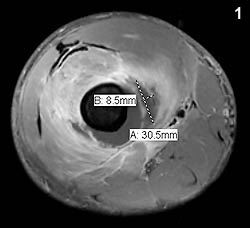
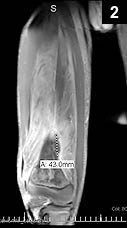
What’s Your Diagnosis?
- Methicillin-sensitive Staphylococcus aureus (MSSA)
- Methicillin-resistant Staphylococcus aureus (MRSA)
- Streptococcus pyogenes (group A strep)
- Gram-negative rods
Answer
The answer is 2, MRSA.
In every study, Staphylococcus aureus clearly leads the list with group A strep being second most common. Other organisms, including Gram-negative enterics, make up a small percentage. Of the Staphylococcus aureus recovered, most are methicillin-resistant.
The patient presented underwent incision and drainage of his subperiosteal abscess and was found to have methicillin-resistant Staphylococcus aureus (MRSA)-positive cultures from the subperiosteal abscess fluid and peripheral blood. The MRSA was sensitive to vancomycin, trimethoprim-sulfamethoxazole and clindamycin (no inducible resistance). The antibiotic coverage was narrowed to maximum dose of clindamycin.
Pyomyositis is a bacterial infection of the skeletal muscle with abscess formation. Muscle abscesses typically afflict patients in hot, humid climates, hence the name “tropical pyomyositis.” Presently, with the emergence of a more virulent community-associated MRSA (CA-MRSA), pyomyositis is reported with increasing frequency in the United States.

Pediatric Infectious Disease, Scott and White's Children's Health Center and Associate Professor of Pediatrics,
Texas A&M University, College of Medicine, Temple, Texas.
e-mail: jhbrien@aol.com
Most strains of CA-MRSA carry the gene for the Panton-Valentine Leukocidin (PVL). PVL is an exotoxin that destroys white blood cells and confers increased virulence to the bacteria. Bocchini et al (2006) demonstrated that children with staphylococcal osteomyelitis who were infected with PVL+ isolates, usually CA-MRSA, were significantly more likely to have concomitant myositis or pyomyositis, and tended to have more subperiosteal or intraosteal abscesses, and had significantly higher mean CRP level (23.1 mg/dL), and were also more likely to have a positive blood culture. Furthermore, a retrospective study by Pannaraj et al. (2006) documented a two-fold increase in pyomyositis and myositis cases at Texas Children’s Hospital between 2000 and 2005. CA-MRSA accounted for most of the increase.
Pyomyositis occurs in three stages (Table 1) and initially can pose a diagnostic dilemma due to the vague nature of complaints. The signs and symptoms are diffuse pain, fever, limp (in lower extremity and pelvic infections), and eventually swelling and redness of the affected muscle. The most common site of infection is the thigh, followed by the calf, buttock, pelvis, arm, chest wall, and spinal muscles. Patients recall history of trauma in about 25% of the cases. In the Pannaraj et al. (2006) study, 49% of the patients had skin barrier penetration secondary to insect bites, minor lacerations, or excoriations.
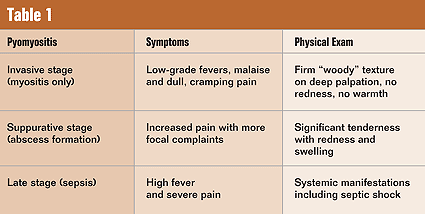
An MRI with gadolinium contrast is the best imaging modality for suspected pyomyositis. Computed tomography (CT) often fails to identify early osteomyelitis and is less sensitive for detecting abscess formation. Generally, surgical incision and drainage of the abscess is required to expedite healing and to isolate the causative pathogen. In some studies, only about a third of blood cultures are positive. WBC, CRP and ESR levels are usually elevated, but muscle enzymes, such as creatinine kinase and aldolase, are almost always normal.
On the day of discharge (hospital day 14), the patient was able to ambulate with a walker and had minimal tenderness with palpation of his right thigh.
He was discharged on oral clindamycin. His CRP level was near normal (3.3 mg/dL.) On orthopedics follow-up his surgical wounds were well-healed. He remains slightly weak given the extensive muscle involvement, but otherwise continues to improve.
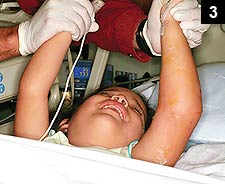

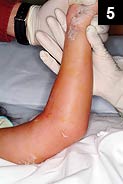
Columnist comments
I would like to thank this month’s guest columnists, Dr. Mikla Derlet and Dr. Sophia Shiau for contributing this excellent case of pyomyositis.
If you are like me, you too are seeing an increase in the number of children with pyomyositis in your practice. The points that Drs. Derlet and Shiau make above are appropriate and timely. Once the diagnosis is suspected, many experts recommend a combination of antibiotics effective against Staphylococcus aureus, group A strep and possibly Gram-negative enterics, depending on any increased risk for Gram-negative organisms (location of infection below the waist, presence of tracheostomy, gastric button, short gut syndrome etc). A variety of combinations might be appropriate. The patient presented was empirically treated with vancomycin and ceftriaxone, pending culture results. Because the MRSA in our community is almost always clindamycin-sensitive, I usually recommend starting with clindamycin, sometimes in combination with gentamicin for possible synergy against Staph as well if fextra Gram-negative coverage is needed.
Some experts will recommend using both vancomycin or clindamycin PLUS nafcillin for unusually severe infections in case the Staphylococcus aureus is methicillin-sensitive, because of its greater activity against sensitive strains. Such was the case with the patient in figures 3 – 5, who had severe MSSA pyomyositis with abscess. She made a rapid recovery after incision and drainage, but interestingly, she was on both vancomycin and nafcillin for three days before definitive drainage was done in the operating room, yet the organism was still recovered. This should remind us of the limitations of antimicrobials against organisms in an abscess cavity.
As much as I hate to admit it, there’s really no substitution for surgical drainage.
For more information:
- Bocchini CE, Hulten KG, Mason EO Jr, et al. Panton-Valentine leukocidin genes are associated with enhanced inflammatory response and local disease in acute hematogenous Staphylococcus aureus osteomyelitis in children. Pediatrics. 2006;117:433-40.
- Pannaraj PS, Hulten KG, Gonzalez BE, et al. Infective pyomyositisand myositis in children in the era of community-acquired, methicillin-resistant Staphylococcus aureus infection. Clin Infect Dis. 2006;43:953-60.
- Small LN, Ross JJ. Tropical and temperate pyomyositis. Infect Dis Clin North Am. 2005;19:981-9.
What’s Your Diagnosis? is a monthly case study featured in Infectious Diseases in Children, with treatment information and discussion to follow.
